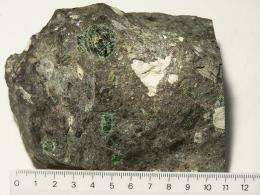Picture of a diamond-bearing kimberlite rock, from a mine somewhere in the US. (Diamonds are not visible). Image: Wikipedia.
(PhysOrg.com) -- Kimberlite, a type of magma that is normally found deep within the Earth’s crust is known to somehow make its way to the surface at times, and when it does, it quite often has diamonds in it. Scientists have long believed that some process whereby some unknown substance being dissolved in water and carbon dioxide was responsible and that the rise was likely rapid, but other than that, had no real good explanation of how they moved upwards. Now, the riddle appears to be solved. Canadian volcanologist Kelly Russell and his colleagues at the University of British Columbia, as they describe in their upcoming paper in Nature, believe that when hot rising magma runs into silica rich minerals, carbon dioxide laden foam is released, forcing the minerals to the surface.
Russell says the leap was made when he and some colleagues tried heating rock samples to 1000°C to mimic the conditions found beneath the Earth’s surface. At one point, he tried sprinkling a silica rich mineral on the hot rocks to see what would happen. After just a few minutes, he writes, there was this foaming, and he and his colleague all knew at once that they’d solved the mystery.
It works like this, they say. When molten rock heavy with carbonate bubbles upwards, it at some point comes into contact with silica laden minerals. All this happens in an upper part of the mantel, where the rock typically has some amount of orthopyroxene in it. Carbon dioxide then bubbles upwards and out of the molten material making the magma buoyant. As it encounters more silica material, it becomes foamier and rises even faster, pushing its way to the surface in as little as just a few hours. The whole process keeps going because of the heat generated by the crystallization of other minerals. When they are exhausted, the process stops.
The whole process results in rocks, such as kimberlite being pushed to the surface, where many thousands or millions of years later, humans find them and begin extracting the diamonds that went along for the ride.
Because kimberlite, named for the town of Kimberly in South Africa where many early diamond mines were dug, is dense with crystals, it should be rather heavy, which would suggest trouble in pushing it up towards the surface. And while it does indeed appear to start out very heavy, it gets lighter as carbon dioxide is released in the reaction with the silicate material, allowing it to more easily be forced to the surface.
More information: Kimberlite ascent by assimilation-fuelled buoyancy, Nature 481, 352–356 (19 January 2012) doi:10.1038/nature10740
Abstract
Kimberlite magmas have the deepest origin of all terrestrial magmas and are exclusively associated with cratons. During ascent, they travel through about 150 kilometres of cratonic mantle lithosphere and entrain seemingly prohibitive loads (more than 25 per cent by volume) of mantle-derived xenoliths and xenocrysts (including diamond). Kimberlite magmas also reputedly have higher ascent rates than other xenolith-bearing magmas. Exsolution of dissolved volatiles (carbon dioxide and water) is thought to be essential to provide sufficient buoyancy for the rapid ascent of these dense, crystal-rich magmas. The cause and nature of such exsolution, however, remains elusive and is rarely specified. Here we use a series of high-temperature experiments to demonstrate a mechanism for the spontaneous, efficient and continuous production of this volatile phase. This mechanism requires parental melts of kimberlite to originate as carbonatite-like melts. In transit through the mantle lithosphere, these silica-undersaturated melts assimilate mantle minerals, especially orthopyroxene, driving the melt to more silicic compositions, and causing a marked drop in carbon dioxide solubility. The solubility drop manifests itself immediately in a continuous and vigorous exsolution of a fluid phase, thereby reducing magma density, increasing buoyancy, and driving the rapid and accelerating ascent of the increasingly kimberlitic magma. Our model provides an explanation for continuous ascent of magmas laden with high volumes of dense mantle cargo, an explanation for the chemical diversity of kimberlite, and a connection between kimberlites and cratons.
Journal information: Nature
© 2011 PhysOrg.com






















